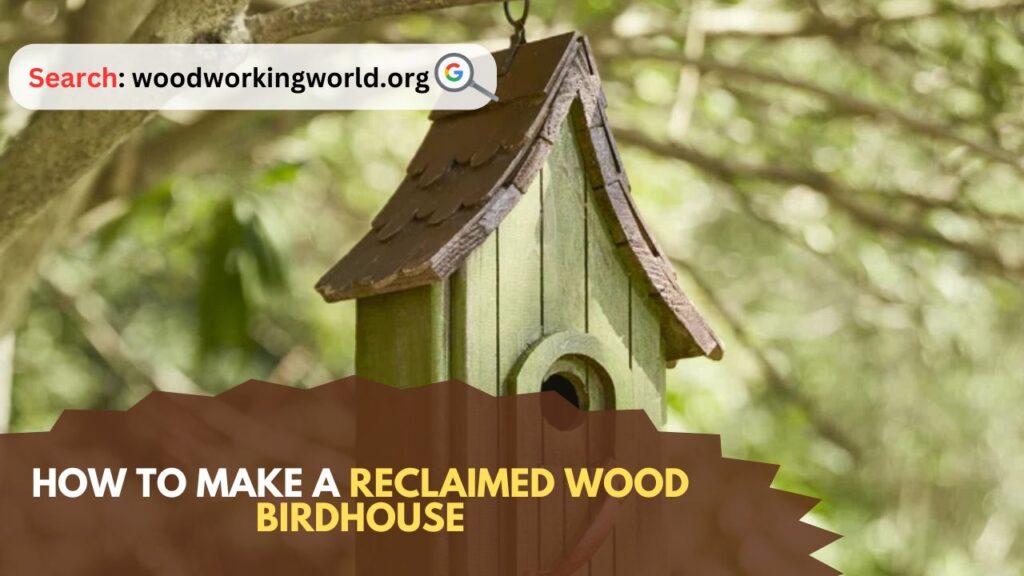Reclaimed Wood Birdhouse: Birdhouses are charming additions to any garden, providing a safe haven for birds and adding rustic beauty to outdoor spaces. Using reclaimed wood for your birdhouse not only gives the project a unique character but also promotes sustainability by repurposing old materials. This article will guide you through the step-by-step process of making a reclaimed wood birdhouse, ensuring you have a rewarding and environmentally friendly DIY experience.

How to Make a Reclaimed Wood Birdhouse
Materials and Tools Needed
Before you begin, gather the following materials and tools:
Materials
- Reclaimed wood (pallets, old fence boards, or barn wood)
- Screws or nails
- Wood glue
- Sandpaper
- Non-toxic paint or wood finish (optional)
Tools
- Tape measure
- Pencil
- Saw (hand saw or circular saw)
- Drill
- Hammer
- Screwdriver
- Clamps (optional)
- Paintbrush (if painting)
Step-by-Step Instructions
1. Planning and Design
Before you start cutting wood, decide on the size and design of your birdhouse. A basic birdhouse consists of a front, back, two sides, a roof, and a base. The dimensions can vary, but a typical small birdhouse might have the following measurements:
- Front and back: 8 inches tall and 6 inches wide
- Sides: 8 inches tall and 5 inches wide
- Roof: 7 inches by 7 inches (two pieces)
- Base: 6 inches by 6 inches
2. Preparing the Wood
Inspect your reclaimed wood for any nails, screws, or debris. Use pliers or a hammer to remove these. Clean the wood with a brush to remove dirt and dust. Sand the wood to smooth rough edges and surfaces, making it safer for both you and the birds.
3. Cutting the Pieces
Measure and mark the wood according to your design dimensions. Use a saw to carefully cut out the front, back, sides, roof, and base pieces. Ensure all pieces fit together properly by dry-fitting them before assembling.
4. Creating the Entrance Hole
Decide on the size of the entrance hole based on the type of birds you want to attract. A 1.5-inch diameter hole is suitable for many small bird species. Mark the center of the front piece and drill the hole. Sand the edges of the hole to smooth any roughness.
5. Assembling the Birdhouse
Begin by attaching the sides to the back piece. Apply wood glue along the edges and use screws or nails to secure the pieces together. Ensure the sides are perpendicular to the back piece. Use clamps to hold the pieces in place if necessary.
Next, attach the front piece with the entrance hole. Apply wood glue to the edges of the sides and secure the front piece with screws or nails. Check for alignment and make any necessary adjustments.
6. Attaching the Base
Attach the base piece to the bottom of the birdhouse. Apply wood glue to the edges of the sides and back, then secure the base with screws or nails. Ensure the base is flush with the edges of the birdhouse.
7. Adding the Roof
The roof consists of two pieces that overlap to create a peak. Attach one roof piece to the top of the birdhouse, securing it with screws or nails. Apply wood glue along the edge of the first roof piece and attach the second piece, ensuring it overlaps to create a weatherproof seal.
8. Finishing Touches
Sand any rough edges or surfaces to ensure the birdhouse is smooth and safe for birds. If desired, apply a non-toxic paint or wood finish to protect the wood from the elements. Choose a finish that is safe for birds and environmentally friendly.
9. Installing the Birdhouse
Choose a suitable location to install your birdhouse. Ideally, it should be placed in a quiet, shaded area away from predators and harsh weather conditions. Use a sturdy pole, tree branch, or mount to secure the birdhouse at least 5-10 feet off the ground. Ensure the birdhouse is stable and level.
10. Maintenance and Care
Regularly check your birdhouse for any signs of wear or damage. Clean it out annually after the nesting season to remove old nesting materials and debris. This helps keep the birdhouse safe and inviting for future bird tenants.
Tips for Success
- Choose the Right Wood: Select reclaimed wood that is free of chemicals, rot, and mold. Cedar, pine, and hardwoods are excellent choices for birdhouses.
- Ensure Proper Ventilation and Drainage: Drill small holes in the bottom of the birdhouse for drainage and in the sides for ventilation. This prevents moisture buildup and keeps the interior dry.
- Keep It Safe: Avoid using treated wood, toxic paints, or finishes that could harm birds. Opt for natural, non-toxic materials.
- Monitor Nesting Activity: Observe the birdhouse from a distance to avoid disturbing the birds. Monitoring nesting activity can be a rewarding experience and helps you understand the needs of your feathered friends.
- Predator Protection: Consider adding a predator guard around the entrance hole to deter predators like raccoons and snakes.
Benefits of Using Reclaimed Wood
Environmental Sustainability
Using reclaimed wood reduces the demand for new lumber, preserving forests and natural habitats. It also minimizes waste by repurposing materials that might otherwise end up in landfills.
Unique Aesthetic
Reclaimed wood has a distinct character and history, giving your birdhouse a rustic, one-of-a-kind appearance. The weathered texture and natural patina add charm and uniqueness to your project.
Cost-Effective
Reclaimed wood is often more affordable than new lumber, making it a cost-effective option for DIY projects. It allows you to create beautiful and functional items without breaking the bank.
Conclusion: Reclaimed Wood Birdhouse
Reclaimed Wood Birdhouse: Building a birdhouse from reclaimed wood is a fulfilling and environmentally friendly project that benefits both you and the local bird population. By following these step-by-step instructions, you can create a charming birdhouse that provides a safe and inviting home for birds while adding rustic beauty to your garden. Embrace the uniqueness of reclaimed wood, enjoy the process of crafting, and take pride in your sustainable creation.
Whether you’re an experienced woodworker or a beginner, this project offers a wonderful opportunity to connect with nature, promote sustainability, and enhance your outdoor space. Happy building!
I hope this article on Reclaimed Wood Birdhouse has been helpful. If you have any further questions, please feel free to leave a comment below.
Video
